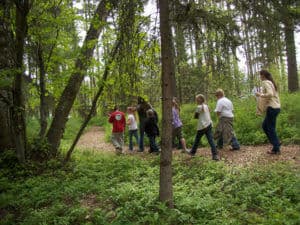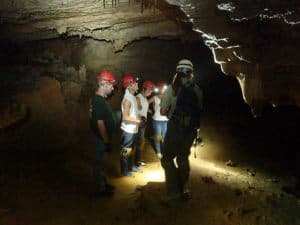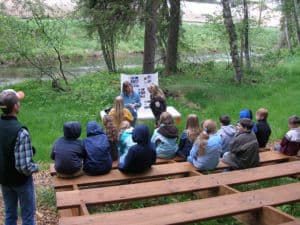
This article outlines the opportunities that outdoor adventurous activities can facilitate within the National Curriculum for physical education. It will also outline how outdoor education can contribute to the fulfilment of government initiatives and curriculum opportunities, and identify how outdoor education can encourage core skills and lifelong physical activity.
Introduction
When Mahatma Gandhi (Beaumont and Whitlam 2009, p. 38) encapsulated the notion of ‘cotton wool kids’ in the following quote, it was not merely a novel concept, but was also an age old issue that humanity has struggled with for many years and is still prevalent today.
Keep a child in cotton wool and stunt it or kill it. If you will let it develop into a robust man, you will expose his body to all weathers teaching him how to defy them.
If we as educators are to provide children and young people with the opportunity to acquire qualities and personal attributes that will equip them with the resilience and creativity required for adulthood, then exposure to demanding and testing challenges is a pre-requisite (Beaumont and Whitlam, 2009).
Physical education can provide opportunities for children and young people to experience situations that are challenging and demanding in nature. These opportunities can be facilitated through a range of activities such as completing the 1500m in athletics, performing a sequence in gymnastics and playing in a football tournament in games. These are all unique experiences relating to a particular area of activity. Outdoor education can also provide unique experiences that are specific to this area of activity. It is through this diversity of learning experience that enables children and young people to acquire the qualities and personal attributes essential for adulthood.
This approach to teaching and learning supports the recommendations suggested by the revised National Curriculum for Physical Education (DCSF/QCA, 2007). It states that students should be offered a range of curriculum opportunities that are integral to their learning and enhance their engagement with the concepts, processes and content of the subject. This could not be achieved through one area of activity alone which reinforces the need of a broad and balanced physical education curriculum. Just some of the learning experiences that can be facilitated through the effective delivery of outdoor education and are outlined below:
Adventure

The notion of adventure is where one embarks on an activity with an associated risk. The risk involved has to strike an even balance in relation to competence in order to achieve peak adventure (Quinn, 1990). The optimisation of learning and enjoyment occurs when the competence of the performer is matched or is slightly outweighed by the demands of the activity. Often the perceived risk involved with outdoor educational activities is quite high. However, when this risk is managed appropriately is only a perceived risk; the actual risk is relatively low.
This can be said for all areas of activity within physical education, as each may have an element of adventure. However, outdoor education is unique in comparison to the other areas of activity in that it can offer a wide range of activities that present the challenge of adventure in different situations. These activities can often be more demanding in nature as the perceived risk or threat is particularly evident, for example, when rock climbing the perceived risk of falling is real as you are putting your trust in other people’s hands. This can also be said for playing in a football match as you put your trust in your team mates, but the consequences of failure are far more severe with rock climbing, and therefore the risk may be perceived as being higher.
Experiential and Active Learning
Outdoor education facilitates experiential learning which is considered to be a major way in which we make sense of the universe (Kraft, 1990). Problem solving is just one example within outdoor education that allows students to use experiential learning using ‘trial and error’ to continually assess the situation in order to perfect techniques and processes. Problem solving activities enable pupils to engage their cognitive and affective thought and learning processes to devise ways in which to overcome problems or evaluate why a problem could not be solved. Problem solving activities enable pupils to devise plans and strategies, adapt to changing environments and exposes them to challenge. Furthermore, allowing pupils to test out their knowledge in practice situations gives pupils the opportunity to develop a more thorough understanding. By fostering opportunities for learners to apply and relate the theoretical and sociological principles in practice, the better they will become at using these principles (Davis, 2009).
Active learning is a process in which learners strive for understanding and competence, and seek out knowledge about the world (Piaget, 1972; Rogers, 1975). This is something that should be promoted as an ethos throughout education, encouraging pupils to take ownership of their own learning, fostering curiosity and interest. This will in turn facilitate the notion of active engagement, whereby it is deemed that pupils learn most effectively when they are interested, involved and appropriately challenged (DfES, 2004). Active learning and active engagement are more likely to be facilitated if students are involved with the learning process. Outdoor education, when conducted in the correct manner, should always be about the internal challenge and process the learner is experiencing.
Moral Development
Mortlock (1984) suggests that outdoor education facilitates the development of self-efficacy, emotional vitality and integrity, unselfishness, compassion, humility, courage, physique, maturity and appreciation of the natural environment. As a physical education teacher this is an attractive compliment of attributes that outdoor education may develop, especially when considering that citizenship education became a statutory part of secondary education in September 2002 (DfES, 2007), and through outdoor education citizenship education may also be facilitated.
Outdoor education can achieve some of the outcomes proposed by the citizenship education National Curriculum, such as passing on enduring values, developing pupils’ integrity and autonomy, and helping them to become responsible and caring citizens, capable of contributing to the development of a just society (DfES/QCA, 2000), through problem solving, teamwork and leadership activities.
Health, Well-being and Physical Activity

The physical attributes promoted through outdoor education include strength, stamina, endurance, cardiovascular fitness, and many more (Mortlock, 1984). High levels of physical activity and cardiorespiratory fitness have been associated with lower levels of morbidity and mortality in both men and women (Blair, Kohl and Barlow 1993, and Paffenbarger, Hyde, Wing, Lee, Jung and Kambert 1993). Research indicates that sedentary people (people who engage in little physical activity) are at greater risk of developing coronary heart disease in comparison with people who are physically active and engage regularly in moderate physical activity (Marcus, Bock, Pinto, Napolitano and Clark 2002). Outdoor education could serve as just one means of trying to increase physical activity levels for children and young adults.
The psychological benefits associated with physical activity include mood enhancement, improved self esteem and self efficacy along with stress and anxiety reduction and management. Psychological development can also be achieved through outdoor education as many activities require determination, self discipline, self-reliance, self-confidence, vitality, integrity, humility and compassion (Mortlock 1984).
Social skills may also be developed through outdoor education as interaction between individuals, other teams and the teacher is a key feature. Examples of some social skills that can be developed include leadership, teamwork and communication to name but a few.
Government Initiatives
The current political climate has acknowledged the value of outdoor education for children and young people. Recent government initiatives have defined the value of outdoor education. These initiatives include The Every Child Matters Agenda (DfES, 2007), High Quality Outdoor Education (Ordinance Survey, 2005) and the Learning Outside the Classroom Manifesto (DCSF, 2008). These initiatives in conjunction with the PESSCL Strategy (DfES, 2002), and The National Curriculum Statutory Inclusion Statement (DfEE/QCA, 1999), will be discussed below in relation to how outdoor education may help facilitate some of the aims associated with these initiatives.
Every Child Matters
Outdoor education can help facilitate the achievement of the five outcomes of the Every Child Matters Agenda (ECM) (DfES, 2007). Each of the five outcomes outlined in the ECM agenda are discussed below in relation to the contribution that outdoor education can provide:
Stay Safe
- Through correct guidance and use of equipment children and young people can stay safe from injury
- Potentially dangerous situations and activities can be undertaken in a controlled environment with specialist equipment and coaches
- Improve the awareness of safe practices in outdoor education
Be Healthy
- Using the outdoor environment to be physically healthy
- Develop and maintain psychological, sociological and emotional health and well-being
- The use of outdoor education to develop, maintain and promote a healthy lifestyle
Enjoy and achieve
- Achieve and enjoy personal and social development and recreation
- Enjoy and appreciate the outdoor environment
- Achieve national educational standards and awards
Achieve Economic Wellbeing
- Provide opportunities for children and young people to engage in further education and training in the outdoors
Make a Positive Contribution
- Engage in decision-making
- Develop positive relationships
- Develop self-confidence and successfully deal with challenges in everyday life
- Engage in law abiding and positive behaviour, within school and the wider community
High Quality Outdoor Education
Good practice in outdoor education is defined in the document High Quality Outdoor Education (Ordinance Survey, 2005). The themes included in this document consist of participation, competition and achievement, residential experiences, differentiation and progression, safety and risk management. This document is available to the public and should be consulted by any physical education department who are unsure about how to deliver high quality outdoor education, and can be used as a guide.
Learning Outside the Classroom Manifesto

- School grounds
- Streetscapes
- Parks
- The countryside
- Leisure centres and public spaces
- Outdoor education centres
- Local nature reserves
- Heritage and cultural sites
- Farms
- Zoos and botanical gardens
- Places of worship
- Museums, theatres and galleries
National Curriculum Statutory Inclusion Statement
Outdoor education facilitates the achievement of the objectives set out by The National Curriculum Statutory Inclusion Statement (DfEE/QCA, 1999), whereby teachers should set suitable learning challenges, respond to pupils’ diverse learning needs and overcome potential barriers to learning. This is predominantly achieved through active participation by all, regardless of skill level or ability. The ethos at the centre of outdoor education is the internal experience and process children and young people undergo, and it is for this reason that outdoor education is accessible for all (Moore 1990).
Conclusion
Outdoor education facilitates unique learning experiences that, in conjunction with the other areas of activity within the National Curriculum for Physical Education, can provide a broad and balanced curriculum, conducive to learning and enjoyment. It is this range and diversity of learning experience that will enable children and young people to acquire the qualities and personal attributes essential for adulthood. After all, imparting knowledge efficiently and encouraging children and young people to become well-rounded individuals is the ultimate aim of teaching (McKeough, Lupart, and Marini, 1995).
References
- Beaumont, G. and Whitlam, P. (2009) Adventure Matters. In Taplin, L. (eds). Physical Education Matters. Journal of the Association for Physical Education. Vol 4, No.1, pp.38.
- Blair, S. Kohl, H. and Barlow, C. (1993) Physical activity, physical fitness and all-cause mortality in women: Do women need to be active? Journal of The American College of Nutrition. 12, pp. 368-371.
- Cale, L. and Harris, J. (2005) Getting the Buggers Fit. London: Continuum International Publishing Group Ltd.
- Davis, B. (2009) Tools for Teaching: Learning Styles and Preferences. Second Edition. San Francisco: Jossey Bass.
- DCSF/QCA. (2008) Learning Outside the Classroom Manifesto. London: HMSO.
- DCSF/QCA. (2007) The National Curriculum: Statutory Requirements for Key Stages 3 and 4. London: HMSO
- DfEE/QCA. (1999) The National Curriculum: Statutory Inclusion Statement. London: HMSO.
- DfES/QCA. (2007) Citizenship: The National Curriculum for England. London: HMSO.
- DfES/QCA. (2007) Every Child Matters: Change for Children. London: HMSO.
- DfES/QCA. (2004) Key Stage 3 National Strategy: Pedagogy and Practice: Teaching and Learning in Secondary Schools – Unit 11: Active Engagement Techniques. London: DfES.
- DfES/QCA. (2002) Physical Education, School Sport and Club Links Strategy (PESSCL). London: DfES.
- DfES/QCA. (2000) The National Curriculum: Handbook for Secondary Teachers in England. London: HMSO.
- Kraft, R. (1990) Experiential Learning. In Miles, J. and Priest, S. (eds). Adventure Education. U.S.A: Venture Publishing Inc.
- Marcus, B. Bock, B. Pinto, B. Napolitano, M. and Clark, M. (2002) Exercise Initiation, Adoption and Maintenance in Adults: Theoretical Models and Empirical Support. In Van Raalte, J. and Brewer, B. (eds). Exploring Sport and Exercise Psychology. Second Edition. Washington: American Psychological Association.
- McKeough, A. Lupart, J. and Marini, A. (eds) (1995) Teaching for Transfer: Fostering Generalization in Learning. Mahwah NJ: Lawrence Erlbaum Associates Inc.
- Moore, G. (1990) Adventure Activities for School Children. In Miles, J. and Priest, S. (eds). Adventure Education. U.S.A: Venture Publishing Inc.
- Mortlock, C. (1984) The Adventure Alternative. Cicerone Press: Cumbria, UK.
- Ordnance Survey. (2005) High Quality Outdoor Education. London: Ordnance Survey.
- Paffenbarger, R. Hyde, R. Wing, A. Lee, I. Jung, D. And Kambert, J. (1993) The association of changes in physical activity level and other lifestyle characteristics with mortality among men. New England Journal of Medicine. 328, pp. 538-545.
- Piaget, J. (1972) Psychology and Epistemology. Harmondsworth: Penguin Books.
- Rogers, C. (1975) Freedom to learn. In Entwistle, N. and Hounsell, D. (eds) How Students Learn. Lancaster: University of Lancaster.
- Quinn, B. (1990) The Essence Of Adventure. In Miles, J. and Priest, S. (eds). Adventure Education. U.S.A: Venture Publishing Inc.


I have worked in the adventure education field in Australia for more than 25 years. I can attest to the strength of the convictions shared in this article.
Put simply, outdoor education (which is simply a narrower field than adventure education, which can occur anywhere) provides opportunities for (a) to be in the outdoors, (b) to play, and (c) to be challenged in ways which involve the whole body.
You may have heard of Project Adventure. It basically took the outdoor adventure philosophies of Outward Bound’s expeditionary learning programs, and placed them inside a classroom. Indeed, the founders of Project Adventure (inc Karl Rohnke, author of the most popular adventure programming text ‘Silver Bullets’) created an alternative Year 9 PE program. Such was its success, it quickly received federal funds to disseminate the program throughout USA and today, Project Adventure’s principles have spread to pretty much every country in the world.
Why was it so successful? Because, in the 1970s, kids were bored to death with skills and drills of the normal PE program, and Project Adventure – which is founded on the basis of play, adventure and often the outdoors – got kids excited about participating in the PE again.
The outdoors is an expansive classroom. And it provides many opportunities to present curriculum which invites students to not only be challenged physically, but also emotionally and mentally. Which is why adventure (and outdoor) education facilitates the development of valuable human characteristics such as strengthening relationships, building empathy, respect, co-operation, trust and leadership, etc.
If you’re a PE teacher wondering how you can bring the outdoors into your classroom, learn more about Project Adventure, or better still sign up to one of their latest partnerships – http://www.playmeo.com – which features the largest collection of group games and activities, ideal for every PE classroom, to develop the very attributes discussed in this article.
Have fun out there, and happy new year to every PE Scholar 🙂
Mark Collard
http://www.playmeo.com
[…] Opportunities for Outdoor Adventurous Activities Within Physical Education National Curriculum […]
What a great article!! I incorporated team building activities in my classes about 8 years ago, when I had no equipment and nothing but a big open field for a classroom. Two years later our whole school went to a local ropes course at a nearby university as an icebreaker, team building exercise to begin our school year. I was hooked, and determined to bring a ropes course to our campus. A year later we received a grant of which I used to create an eight element course. With the help of a generous professor, Home Depot, and many community volunteers the course became a reality. Every semester my classes get the opportunity to go through the course as well as other activities to promote experiential learning. I love how OAA levels the PE playing field. Every student can achieve success!
Six years later, I now have my high school students leading visiting middle school students through the course. Watching my students lead others is a priceless learning experience.
I hope your article will inspire other teachers to pursue OAA so more students can have learning experience that will last a lifetime!!
Thank you for the positive comments.
I believe the power of the outdoors and outdoor education is so important especially today where as a society we are increasingly bound to computers and life’s stresses. It is increasingly becoming easier to vicariously experience the challenge and adventure that the outdoors brings through television programmes and multi-media programmes, but this vicarious experience does not do the real thing any justice at all. There is nothing better than getting out in the outdoors and experiencing adventure first hand, taking the time to escape from the humdrum of daily routines and stresses, which reminds us that we are alive are not just people in the hamster wheel of life.
Great Article
we are very lucky to be able to take all of our students to the river 6 weeks every year to kayak and canoe as part of their PE & Games Programme – not cheap – but money worth spending
[…] To continue to read the full article on PE Scholar please click here. […]